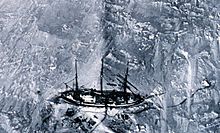Gauss expedition

The Gauss expedition (1901–1903) was the first German Antarctic expedition and was undertaken by the polar explorer and geology professor Erich von Drygalski on the tall ship Gauß . The aim of the expedition was to explore the unknown area south of the Kerguelen .
expedition
The Gauss left Kiel in the summer of 1901 . A small group of researchers (including Josef Enzensperger , Karl Luyken and Emil Werth ) were stationed on the Kerguelen, while the other men drove further south. The expedition stopped on the island of Heard and undertook the first comprehensive investigations into the geology , flora and fauna of the island. During the expedition, 9 new species and 3 subspecies within the class of Hexactinellidae were discovered, as well as species from the genera Hyalonema , Caulophacus , Chonelasma , Bathyxiphus and Aulocalyx detected at a depth of 2400–3400 m. As of 1910, there were 26 species of Antarctic hexactinellids, 19 of which belonged to the Rossellids .
The expedition later discovered new Antarctic regions, although they were stuck in the ice for almost 14 months and were only released again in February 1903. The new area was christened Kaiser-Wilhelm-II.-Land , and the ship became the namesake of the extinct volcano Gaußberg .
Drygalski was the second researcher after Robert Falcon Scott to use a tethered balloon in Antarctica .
Return and evaluation
In November 1903 the tall ship Gauß arrived back in Kiel . Subsequently, Erich von Drygalski wrote the report on the expedition and processed the extensive scientific data. Between 1905 and 1931 he published 20 volumes and two atlases documenting the expedition.
See also
- List of participants in the Gauss expedition
- Second German Antarctic Expedition
- Third German Antarctic Expedition
- List of Antarctic expeditions
- Carl Friedrich Gauß : namesake of the ship
literature
- Erich von Drygalski: To the continent of the icy south . German south polar expedition. Journeys and research by the "Gauss" 1901–1903. Reimer, Berlin 1904.
Individual evidence
- ↑ Erich von Drygalski: Deutsche Südpolar-Expedition 1901-1903, Volume 7, Zoologie Volume 4, No. 1, Verlag Georg Reimer, Berlin June 1910, p. 5.
- ^ Franz Eilhard Schulze & R. Kirkpatrick: The Hexactinellids of the German South Pole Expedition 1901-1903. In: German South Polar Expedition 1901–1903. Volume 7, Zoology Volume 4, No. 1, Verlag Georg Reimer, Berlin June 1910, p. 6.
Web links
- Report on Von Drygalski and the expedition
- Report on the stay on the Kerguelen by Karl Luyken , member of the expedition
- Erich von Drygalski: To the continent of the icy south , Georg Reimer Verlag, Berlin 1904.

